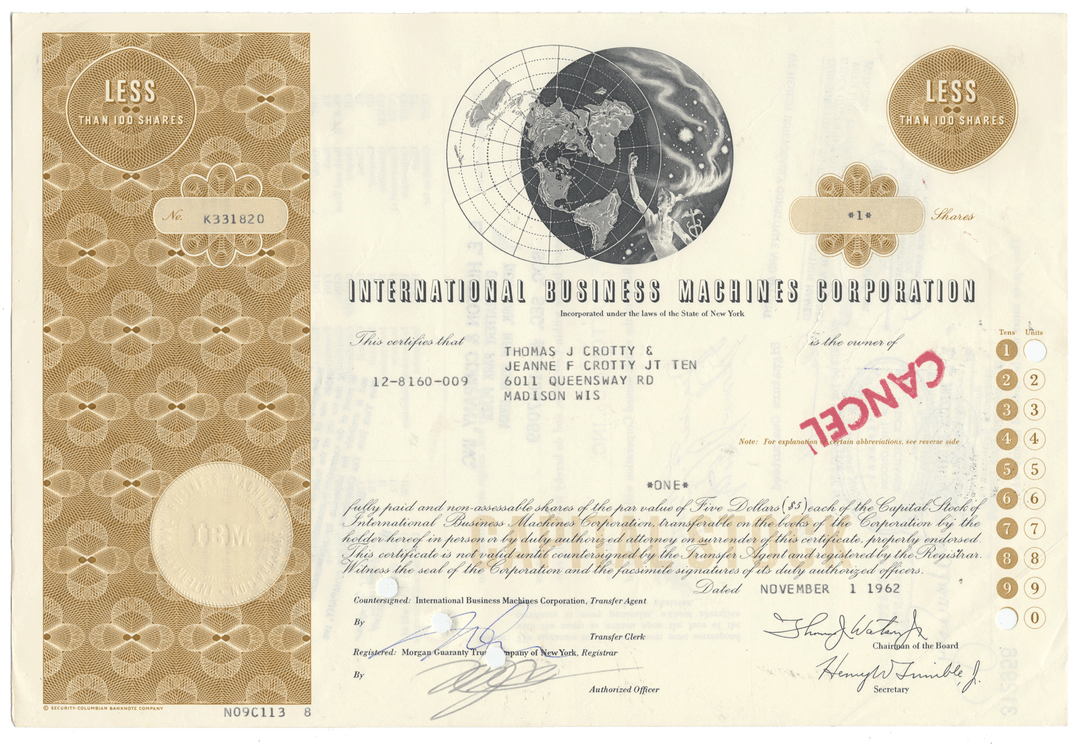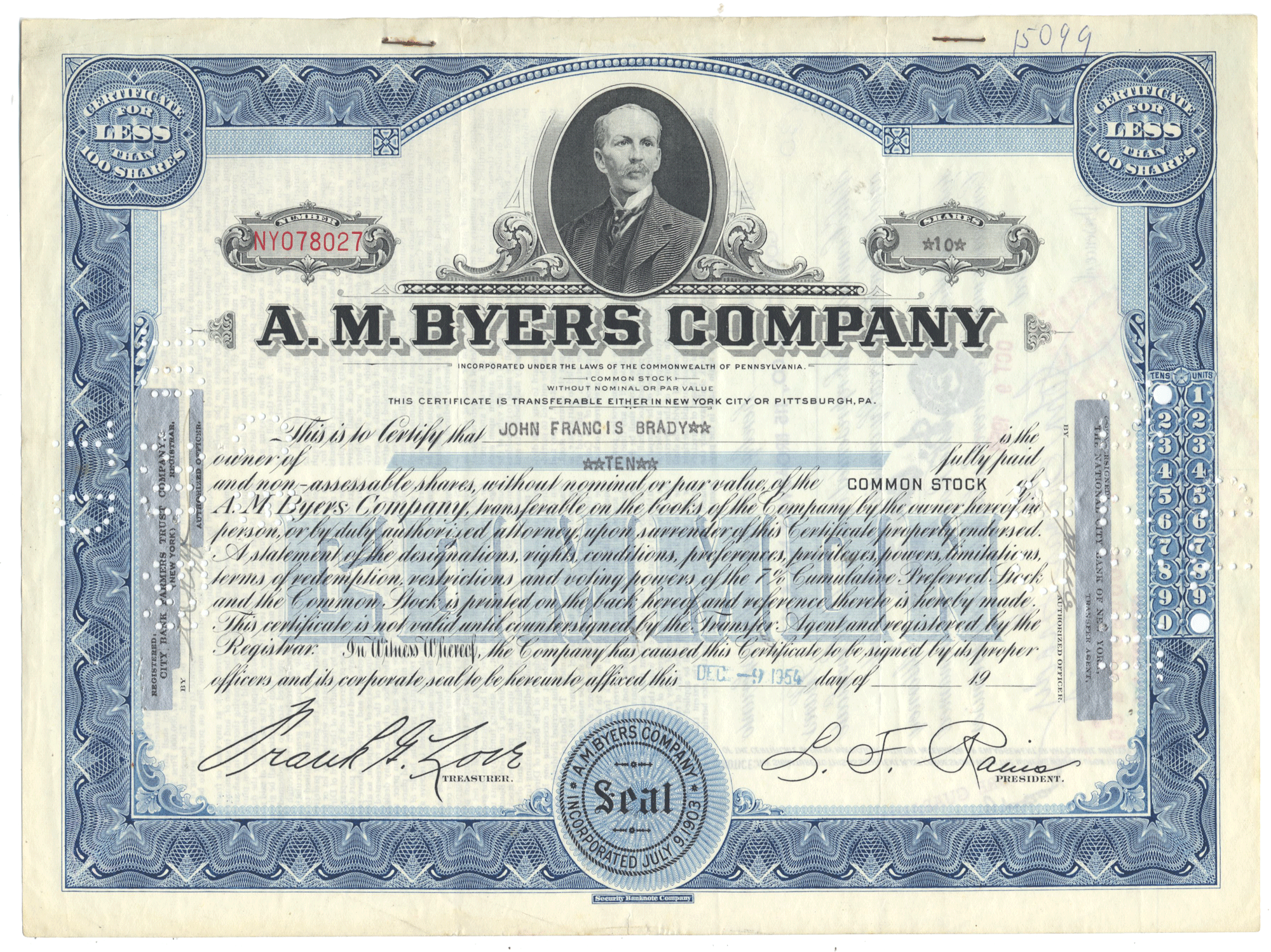
International Business Machines Corporation (IBM)
- Guaranteed authentic document
- Orders over $75 ship FREE to U. S. addresses
Product Details




Certificate Type
Capital Stock
Date Issued
1960's
Canceled
Yes
Printer
American Bank Note Company
Signatures
Machine printed
Approximate Size
12" (w) by 8" (h)
Additional Details
NA
Historical Context

In the 1880s, technologies emerged that would ultimately form the core of International Business Machines (IBM). Julius E. Pitrat patented the computing scale in 1885; Alexander Dey invented the dial recorder (1888); Herman Hollerith patented the Electric Tabulating Machine; and Willard Bundy invented a time clock to record a worker's arrival and departure time on a paper tape in 1889. On June 16, 1911, their four companies were amalgamated in New York State by Charles Ranlett Flint forming a fifth company, the Computing-Tabulating-Recording Company (CTR) based in Endicott, New York.
The five companies had 1,300 employees and offices and plants in Endicott and Binghamton, New York; Dayton, Ohio; Detroit, Michigan; Washington, DC; and Toronto. They manufactured machinery for sale and lease, ranging from commercial scales and industrial time recorders, meat and cheese slicers, to tabulators and punched cards. Thomas J. Watson, Sr., fired from the National Cash Register Company by John Henry Patterson, called on Flint and, in 1914, was offered CTR. Watson joined CTR as General Manager then, 11 months later, was made President when court cases relating to his time at NCR were resolved. Having learned Patterson's pioneering business practices, Watson proceeded to put the stamp of NCR onto CTR's companies. He implemented sales conventions, "generous sales incentives, a focus on customer service, an insistence on well-groomed, dark-suited salesmen and had an evangelical fervor for instilling company pride and loyalty in every worker". His favorite slogan, "THINK", became a mantra for each company's employees. During Watson's first four years, revenues reached $9 million and the company's operations expanded to Europe, South America, Asia and Australia. "Watson had never liked the clumsy hyphenated title of the CTR" and in 1924 chose to replace it with the more expansive title "International Business Machines". By 1933 most of the subsidiaries had been merged into one company, IBM.
In 1937, IBM's tabulating equipment enabled organizations to process unprecedented amounts of data, its clients including the U.S. Government, during its first effort to maintain the employment records for 26 million people pursuant to the Social Security Act, and Hitler's Third Reich, largely through the German subsidiary Dehomag. During the Second World War the company produced small arms for the American war effort (M1 Carbine, and Browning Automatic Rifle).
In 1949, Thomas Watson, Sr., created IBM World Trade Corporation, a subsidiary of IBM focused on foreign operations.In 1952, he stepped down after almost 40 years at the company helm, and his son Thomas Watson, Jr. was named president. In 1956, the company demonstrated the first practical example of artificial intelligence when Arthur L. Samuel of IBM's Poughkeepsie, New York, laboratory programmed an IBM 704 not merely to play checkers but "learn" from its own experience. In 1957, the FORTRAN scientific programming language was developed. In 1961, IBM developed the SABRE reservation system for American Airlines and introduced the highly successful Selectric typewriter. In 1963, IBM employees and computers helped NASA track the orbital flight of the Mercury astronauts. A year later, it moved its corporate headquarters from New York City to Armonk, New York. The latter half of the 1960s saw IBM continue its support of space exploration, participating in the 1965 Gemini flights, 1966 Saturn flights and 1969 lunar mission.
Related Collections
Additional Information
Certificates carry no value on any of today's financial indexes and no transfer of ownership is implied. All items offered are collectible in nature only. So, you can frame them, but you can't cash them in!
All of our pieces are original - we do not sell reproductions. If you ever find out that one of our pieces is not authentic, you may return it for a full refund of the purchase price and any associated shipping charges.





